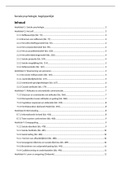Resume
Samenvatting Sociale psychologie, begrippenlijst
D.m.v. deze begrippenlijst een 8,2 gehaald! Bevat begrippen met betekenis uit de hoofdstukken 1,2,3,7,8,9 uit het boek Sociale psychologie - Roos Vonk. De begrippenlijst is geschreven voor het vak Sociale psychologie - Toegepaste psychologie op Fontys hogescholen Eindhoven.
[Montrer plus]
Livre entier ?
Non
Quels chapitres sont résumés ?
Hoofdstuk 1,2,3,7,8,9
Publié le
16 août 2021
Nombre de pages
13
Écrit en
2020/2021
Type
Resume
Titre de l’ouvrage: Sociale Psychologie
Auteur(s): R. Vonk
Édition: juli 2017 ISBN: 9789089537850 Édition: 4
Resume
Samenvatting Sociale Psychologie
Resume
Sociale psychologie samenvatting van het boek, 8 gehaald
Resume
Samenvatting Sociale Psychologie (boek en colleges)
Tout pour ce livre (40)
Établissement
Fontys Hogeschool (Fontys)
Cours
Toegepaste Psychologie
Cours
Sociale Psychologie (TP1CSOPSY)
Tous les documents sur ce sujet (36)
Par: lindseyjoosen • 2 année de cela
S'abonner
€5,86
Egalement disponible en groupe à partir de €23,49
Garantie de satisfaction à 100%
Disponible immédiatement après paiement
En ligne et en PDF
Tu n'es attaché à rien
Document également disponible en groupe (1)
Theorievakken (5x) Toegepaste Psychologie - Fontys jaar 1, samenvattingen & begrippenlijsten
€ 29,30
€ 23,49
5 éléments
1. Resume - Inleiding in de psychologie, samenvatting & begrippenlijst
2. Resume - Persoonlijkheidsleer, samenvatting & begrippenlijst
3. Resume - Ontwikkelingspsychologie, samenvatting
4. Resume - Sociale psychologie, begrippenlijst
5. Resume - Spss, samenvatting
Montrer plus
Sociale psychologie; begrippenlijst





